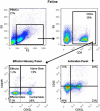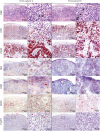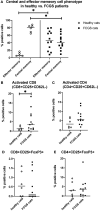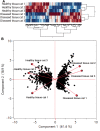Histological, Immunological, and Genetic Analysis of Feline Chronic Gingivostomatitis
- PMID: 32582783
- PMCID: PMC7283503
- DOI: 10.3389/fvets.2020.00310
Histological, Immunological, and Genetic Analysis of Feline Chronic Gingivostomatitis
Abstract
Feline chronic gingivostomatitis (FCGS) is an immune-mediated inflammatory condition affecting the oral mucosa that results in substantial pain and suffering. The goal of this study was to complete an in-depth immunohistochemistry analysis of affected FCGS mucosa, to perform and compare immune cell phenotypes in the blood of FCGS and healthy controls cats, and to determine a transcriptomic profile of the affected and normal oral mucosa of FCGS cats. We hypothesized that cats with FCGS would have circulating activated CD8+ T cells and that tissues would be infiltrated with activated B and T cells with a highly proinflammatory transcriptome. We found that oral mucosal tissues from cats with FCGS have high tissue infiltration of B cells and that T cells include both CD4+ and CD8+ lymphocytes. Cells positive for CD25 (IL2 receptor, indicative of lymphocyte activation) and FOXP3 (indicative of regulatory T cells) were scattered throughout the mucosa. Compared to healthy individuals, cats with FCGS had high circulating CD8+ effector memory cells with a concurrent decrease in central memory cells and evidence of circulating activated CD8+ T cells (CD25+, CD62L-). Gene expression in the affected tissues was enriched for genes associated with T-cell signaling, cell adhesion molecules, leukocyte migration, inflammatory signaling pathways, extracellular matrix-receptor interactions, cytokine-cytokine receptor interactions, and natural killer cell-mediated cytotoxicity, among others. These data are essential to understand disease pathogenesis, to inform mechanism of action studies for future and current therapies, and to help select prognostic biomarkers and potency assays for stem cell treatment of FCGS.
Keywords: chronic feline stomatitis; feline oral mucosal disease; immune-mediated oral mucosal inflammation; immunohistochemistry of feline stomatitis; immunophenotyping of FCGS; transcriptome of chronic gingivostomatitis.
Copyright © 2020 Vapniarsky, Simpson, Arzi, Taechangam, Walker, Garrity, Bulkeley and Borjesson.
Figures




Similar articles
-
Use of unbiased metagenomic and transcriptomic analyses to investigate the association between feline calicivirus and feline chronic gingivostomatitis in domestic cats.Am J Vet Res. 2021 May;82(5):381-394. doi: 10.2460/ajvr.82.5.381. Am J Vet Res. 2021. PMID: 33904799
-
Feline Chronic Gingivostomatitis Diagnosis and Treatment through Transcriptomic Insights.Pathogens. 2024 Feb 21;13(3):192. doi: 10.3390/pathogens13030192. Pathogens. 2024. PMID: 38535535 Free PMC article.
-
Expression of cannabinoid and cannabinoid-related receptors in the oral mucosa of healthy cats and cats with chronic gingivostomatitis.J Feline Med Surg. 2021 Aug;23(8):679-691. doi: 10.1177/1098612X20970510. Epub 2020 Nov 11. J Feline Med Surg. 2021. PMID: 33174485 Free PMC article.
-
Stromal cell therapy in cats with feline chronic gingivostomatitis: current perspectives and future direction.J Feline Med Surg. 2023 Aug;25(8):1098612X231185395. doi: 10.1177/1098612X231185395. J Feline Med Surg. 2023. PMID: 37548494 Free PMC article. Review.
-
Feline chronic gingivostomatitis current concepts in clinical management.J Feline Med Surg. 2023 Aug;25(8):1098612X231186834. doi: 10.1177/1098612X231186834. J Feline Med Surg. 2023. PMID: 37548475 Free PMC article. Review.
Cited by
-
A Case Series Analysis of Dental Extractions' Outcome in Cats with Chronic Gingivostomatitis Carrying Retroviral Disease.Animals (Basel). 2021 Nov 19;11(11):3306. doi: 10.3390/ani11113306. Animals (Basel). 2021. PMID: 34828037 Free PMC article.
-
The prevalence of reasons for tooth extraction in cats.Front Vet Sci. 2025 Jul 14;12:1626701. doi: 10.3389/fvets.2025.1626701. eCollection 2025. Front Vet Sci. 2025. PMID: 40727267 Free PMC article.
-
Salivary peptidomic profiling of chronic gingivostomatitis in cats by matrix-assisted laser desorption/ionization-time-of-flight mass spectrometry and nanoscale liquid chromatography-tandem mass spectrometry.J Vet Intern Med. 2025 Jan-Feb;39(1):e17247. doi: 10.1111/jvim.17247. Epub 2024 Nov 22. J Vet Intern Med. 2025. PMID: 39576047 Free PMC article.
-
Co-occurrence of feline chronic gingivostomatitis and oral squamous cell carcinoma in 4 cats (2014-2024).Front Vet Sci. 2025 Apr 29;12:1564674. doi: 10.3389/fvets.2025.1564674. eCollection 2025. Front Vet Sci. 2025. PMID: 40365130 Free PMC article.
-
Case Report: Xenogeneic mesenchymal stem cell secretome for the treatment of feline chronic gingivostomatitis.Front Vet Sci. 2025 Jun 19;12:1603383. doi: 10.3389/fvets.2025.1603383. eCollection 2025. Front Vet Sci. 2025. PMID: 40612155 Free PMC article.
References
-
- Quimby JM, Elston T, Hawley J, Brewer M, Miller A, Lappin MR. Evaluation of the association of Bartonella species, feline herpesvirus 1, feline calicivirus, feline leukemia virus and feline immunodeficiency virus with chronic feline gingivostomatitis. J Feline Med Surg. (2008) 10:66–72. 10.1016/j.jfms.2007.05.007 - DOI - PMC - PubMed
Grants and funding
LinkOut - more resources
Full Text Sources
Molecular Biology Databases
Research Materials
Miscellaneous

